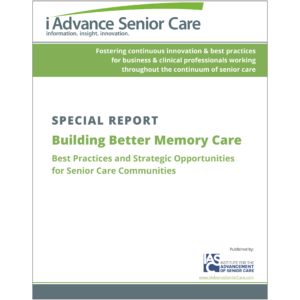Strategies to Support the Families of Memory Care Residents
Placing a family member in a memory care facility can be a difficult and emotional decision. Memory care facilities play an important role in supporting not only the resident, but also the family members, too. Focusing on resident and family member support can help to make the transition easier, and can also ease family members’ concerns long-term.
The Challenges Faced by Family Members

Adria Thompson, owner of Be Light Care Consulting
Adria Thompson, owner of Be Light Care Consulting, points out that family members face complex emotions and challenges. She explains that the emotional toll of deciding to place a loved one in care can be particularly trying. “Unfortunately, a bias and stigma can be attached to care facilities, resulting in feelings of guilt, shame, and failure,” she says. “Whether the pressure comes from their own expectations of their abilities or pressure from others, it can be very upsetting.”
Family members may also face a challenge in communicating with facility staff and defining the proper expectations for their loved ones’ care. “The foundation of all frustration and disappointment is unmet expectations,” says Thompson. She highlights the importance for conversations around what happens in high-stress situations like when a resident falls, exhibits adverse behaviors, or experiences a medical emergency. Having these conversations ensures that the family and facility staff are on the same page, and helps to avoid unexpected situations.
Thompson explains that families also experience frustration when they feel that their loved ones are not known. They may make comments like, “This is not how my mom was” or “My dad would be so embarrassed if he knew he was treating someone like that.” “Families want staff to really know their loved ones as they are now, but also how they were before the diagnosis,” says Thompson. “This is an easily overlooked component to care but so important to provide person-centered care and respect the dignity and legacy of residents.”
Best Practices to Support Memory Care Residents’ Families
When family members ask the question, “How’s Mom today?” Thompson encourages memory care facilities to take the time to answer with detail. “A staff person may answer, ‘She’s good! The same,’ thinking the family member is worried something is wrong, but failing to realize they just want to feel included in their parent’s life and day,” she explains. “Because individuals with dementia often experience short term memory loss, they aren’t able to answer those questions themselves and staff members are the only witnesses to the details of their day and their mood. Family members long to feel included.”
It’s equally important for staff to verify that they are providing family members with accurate information. Thompson notes that it’s common for family members to not know whom to ask specific questions, which can lead to conflicting information. A staff member might be tempted to provide a “best guess” answer, but that can result in extremely frustrating miscommunication. Taking the time to connect the family member to the right staff person, or to verify the information to be relayed, can help to avoid this situation.
When supporting family members emotionally, Thompson highlights the importance of clearly communicating the expectations that they need to have in emergency situations. “Providing written communication at move-in regarding the process of what may happen in the event of a fall, a medical emergency, or if they exhibit dangerous or adverse behaviors will allow families to feel more in control,” she explains. “Feeling blindsided by conversations about sending a resident to the emergency room, prescribing new medications, implementing interventions, or requesting a sitter or family member for a period of time can feel traumatic.” Being prepared for an emergency can help to comfort family members.
Thompson also notes how important language is when communicating with family members. “In order to support families emotionally, staff of memory care units need to consider the impact of their words,” she says. “It is important to consider the effect of using words with negative connotations, such as describing their loved ones or their behaviors as ‘combative,’ ‘aggressive,’ ‘refusing,’ ‘manipulating,’ or ‘destructive.’
“Instead, it is important to remember that these adverse ‘behaviors’ are just a form of communication and instinctual reactions to the environment from a person with a degenerative brain disease,” says Thompson. “These tough moments can be better described with words such as ‘experiencing frustration,’ ‘reacted with anger,’ ‘declined to participate,’ or ‘expressed to us that they were stressed.’ These conversations with family can often place guilt or blame on them unnecessarily and have been described as feeling like they were ‘called to the principal’s office.’”
Finally, putting extra effort into communicating with family members can offer a feeling of reassurance and help the family members to feel like they’re well-connected with their loved ones. Thompson recommends posting photos on social media (with a photo release in place), so that family members can see their loved ones enjoying special moments. Facilities may want to use software like LifeLoop, which allows staff, residents, and family members to send and receive messages and photos.
Having a loved one in a memory care facility can be extremely difficult for family members. By taking some extra time to ensure that the family members receive the communication and support they need, a memory care facility can play a key role in making this difficult time easier for residents and their families.

Paige Cerulli is a contributing writer to i Advance Senior Care.
Related Articles
Topics: Activities , Administration , Alzheimer's/Dementia , Facility management , Featured Articles , Medicare/Medicaid , Resident Care , Staffing











